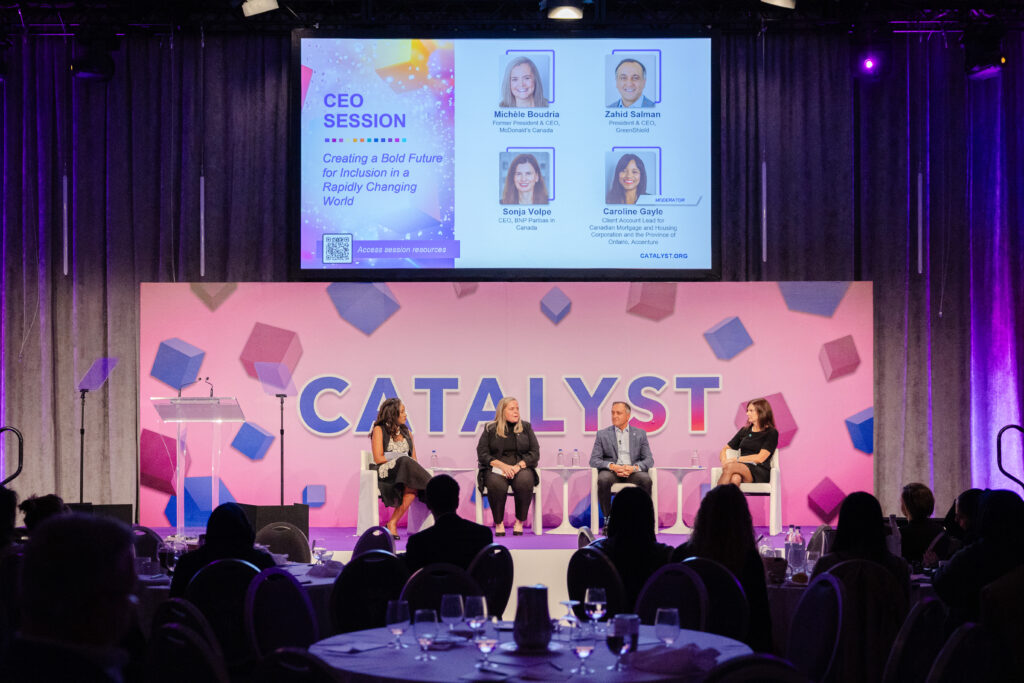Key Takeaways from the Catalyst Honours Conference: Creating a Bold Future for Inclusion
The 2025 Catalyst Honours Conference brought together over 650 of Canada’s most influential business leaders and inclusion champions to discuss powerful solutions for today’s most pressing workplace challenges and define the future of inclusion. As a sponsor of this year’s conference, BNP Paribas in Canada was proud to provide tickets to community leaders and underrepresented groups to foster meaningful participation and ensure that these marginalized voices had a seat at the table.
With this year’s theme, “Inclusion by design: Breaking barriers, building belonging,” leaders were urged to embed inclusion into the very foundation of work— bridging the gap between strategy and implementation, and transforming policies into tangible outcomes. Sonja Volpe, CEO of BNP Paribas in Canada and recipient of the 2025 Catalyst Honours Champion for her transformative work accelerating workplace inclusion, shared powerful insights on how organizations can embed inclusion into their DNA, ensuring it becomes a pillar of long-term resilience and growth.
From Hiring to Belonging: Building an Inclusive Culture
The days of treating DEI solely as a recruitment exercise are over. Today, inclusion is a growth engine—directly tied to innovation, talent retention, and financial performance.
“When employees feel valued and free to be themselves, they perform better. And when people perform better, the organization performs better.”
Sonja Volpe, CEO, BNP Paribas in Canada
At BNP Paribas in Canada, this means:
- Dedicated DEI recruiters and a neurodiversity hiring program to expand access to diverse talent and build a representational workforce that reflects the diversity of the communities we operate in.
- Inclusive leadership training for all Canada managers, as well as trainings for all employees on tackling unconscious bias.
- DEI objectives for all managers to ensure accountability at every level.
- Over 60 DEI events annually, led by our very active network of Employee Resource Groups (ERGs).
- Multiple mentorship and leadership programs for women to create pathways for women’s inclusivity in senior leadership and ensure that inclusion outlasts individual tenures.
Ultimately, inclusion is not a one-time initiative— it is a continuous, collective effort to dismantle barriers and cultivate a culture that embraces all differences so that each employee can be their authentic selves.

Inclusion as a Leadership Priority
For inclusion to truly take root, organizations must view DEI as every leader’s responsibility, rather than solely part of HR’s mandate.
At BNP Paribas in Canada, the DEI team reports directly to the CEO, while regular reviews with the heads of business lines track diversity metrics, benchmarks, challenges, and more— not only keeping DEI top of mind, but ensuring that inclusion is integrated into the strategic and operational planning of the Bank and regular monitoring, rather than treated as an afterthought.
The key insight? The most successful organizations embed inclusion into all aspects of their activities, from leadership and governance to services, operations, employee engagement and even benefits.
Intersectionality: Recognizing That One Size Doesn’t Fit All
Importantly, true inclusion requires an intersectional approach— acknowledging that employees bring multiple identities that can intersect and shape their unique experiences.
Organizations must foster cultures that are inclusive to employees across all their intersecting identities, and recognize that a one-size-fits-all approach to inclusion often overlooks the distinct challenges that employees from underrepresented backgrounds can face.
At BNP Paribas in Canada, we have placed a strong emphasis on intersectionality throughout all our inclusion initiatives including:
- Panels on women’s intersecting identities in the workplace.
- Trainings on visible and invisible disabilities.
- Roundtables on the diverse experiences of the Black diaspora and the Asian diaspora.
- Workshops on becoming aware of privilege, intersectionality, and more through our Pride Employee Resource Group.
The Bold Future for Inclusion: Continuous Evolution, Not a Destination
Sonja Volpe stressed that organizations must treat inclusion as a living, evolving practice—not as static achievement or trend.
At BNP Paribas in Canada, this means setting up pathways for women’s inclusivity in senior leadership through our multiple mentorship and female leadership programs. It also involves regular monitoring and benchmarking to keep inclusion efforts dynamic and responsive, as well as ensure that we constantly develop and improve our processes so that every employee is supported and empowered to thrive.
Ultimately, the 2025 Catalyst Honours Conference reaffirmed BNP Paribas in Canada’s longstanding belief that inclusion and belonging are key for our continued success. As the bank for a changing world, it is part of the way we are attracting and retaining top talent, driving innovation, and strengthening resilience for the future.